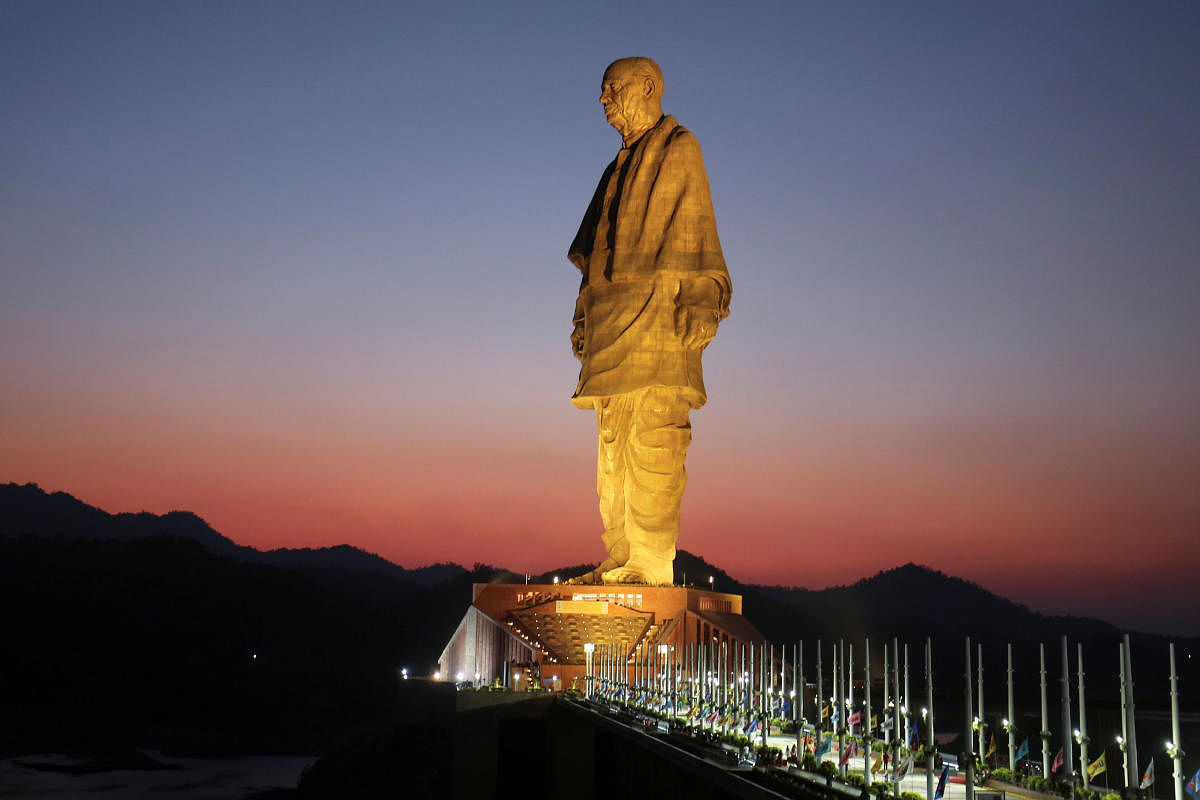
From the front ‘kitchen garden’ of the Tadvi family who live in a thatched house, the giant statue of the country’s first home minister Sardar Vallabhbhai Patel, known as the ‘Statue of Unity’, looks formidable. The grey, 182m tall structure stands out in the cloudy sky amidst a canopy of the lush green Aravalli foothills. But the Tadvis may not be able to look out of their little house at this grandeur for much longer – they are to be evicted from their home soon.
It’s not the Tadvis alone, either. Nearly 5,000 tribals are to be evicted, to make way for facilities for tourists who have been thronging the place to take a glimpse of the Rs 3,000-crore “marvel.” In the coming months, in the place of the kuchha-pucca houses of these tribals will come up swanky hotels, safari parks and other recreational extravaganza.
“They want us to move out from this land that I have inherited from my forefathers. In lieu of our eviction, the government is not even giving enough land or compensation that will allow my family to live a decent life,” says Punabhai Tadvi, as he shows documents kept neatly in plastic bags at his house in Navagam village near Kevadiya Colony, which is where the “world’s tallest statue,” and the Sardar Sarovar Dam on the Narmada river, are located.
Like in Punabhai’s Navagam, tribals living in Kevadiya, Vadhadiya, Limbdi, Kothi and Gora villages are being displaced from their residential and farm lands.
They are the last villagers left in the middle of the changing landscape—thanks first to the dam, and then the statue and now the Gujarat government’s plan to build facilities for tourists. Although these lands were acquired by the government in the 1960s, they had remained in the possession of the tribals.
Dinesh Tadvi, 49, a resident of Vaghadhiya village, said, “The construction of the dam and the statue are complete. There are enough lands for the government to build facilities and parks to attract tourists without disturbing our settlements. We also want to be part of this development and earn our livelihood.”
“It is ironic that government wants to bring ‘development’ here, and for that they want us to leave this place, instead of giving us opportunity. They want to get rid of poor tribals and give our lands to rich urban people who will build hotels and malls here,” the former village sarpanch said.
Punabhai’s appeals to the Grievances Redressal Authority for Sardar Sarovar Project-Affected Persons have been fruitless for the last two decades as the authorities dismissed them stating that his land was acquired for the purpose of Weir Dam, to be constructed on downstream on the Narmada river.
The redressal authority’s order does mention that “initially, it was acquired for the project but later on, the site of the project came to be shifted and the land fell out of submergence area of main dam and remained idle with the government, and now it is going to be used in the Gurudeshwar Weir Project.”
Recently, a public interest litigation (PIL) was also filed in the Gujarat high court objecting to the eviction of tribals from their farms and ancestral homes where their families have been living for centuries. The PIL states that the lands of these villages were ordered to be acquired but the possession remained with the villagers.
According to the petition, land acquisition started in 1961-62 for the purpose of constructing a colony under the Narmada River Project Scheme. In all, 19 villages were directly affected, including Kevadiya and five other villages, where the tribals are facing eviction. The villagers said that nearly 85% of the people of these 19 villages were awarded compensation and have left, but the other 15% have stayed put.
Today, there are more than 5,000 tribals who are staying in these six villages. They have voter identity cards, Aadhaar numbers, electricity bills, property taxes among other documents that establish their rights over the lands.
The PIL says that the government wants to displace the tribals to build hotels, a tiger safari, 33 state bhavans, etc. The petition says that “the land acquisition proceedings for the land in question has already lapsed as per Section 24(2) of the new land
acquisition law passed in 2013, as neither the possession was taken by the government nor any compensation was paid to the affected people. Yet, the state government, without any authority of law, is forcefully evicting the Adivasi people residing in the villages…”
Whenever there is a VIP visit in the vicinity, an 80-year-old retired primary teacher, who requested not to be named, is ordered to shut his grocery store that is located near the helipad, which is close to the Patel statue. “The police come knocking on my door whenever there is a visit by our chief minister or other VIPs, ordering me to close my shop. Where will I go if I’m not permitted to do business.”
The retired teacher runs his shop in a hut that is full of packets of snacks, plastic bags, ropes and other essentials. “I thought tourists would bring business for locals, but now I realise all this was not for us. It makes me sad to think that we, the Tadvi Adivasi, who settled along the Narmada river centuries ago, are being forced to leave this place for the rich people who are coming here to do business.”
The tea stall of Jagadish, a relative of the old teacher, was recently destroyed by the Authority. He has since opened another shop near the statue. “Only local labourers come to my place to have tea and snacks. The number of tourists has been increasing but my shop is still untouched by these opportunities.”